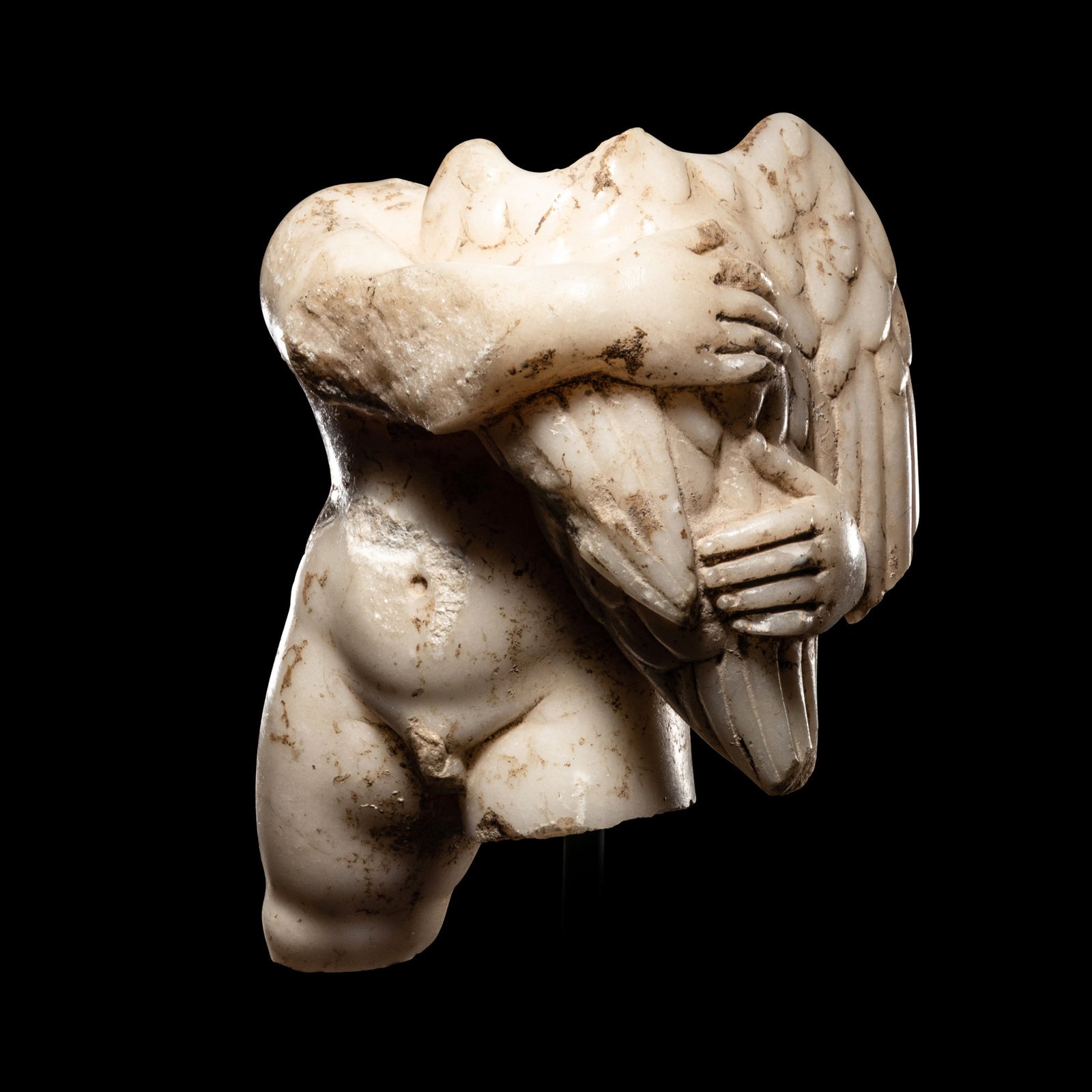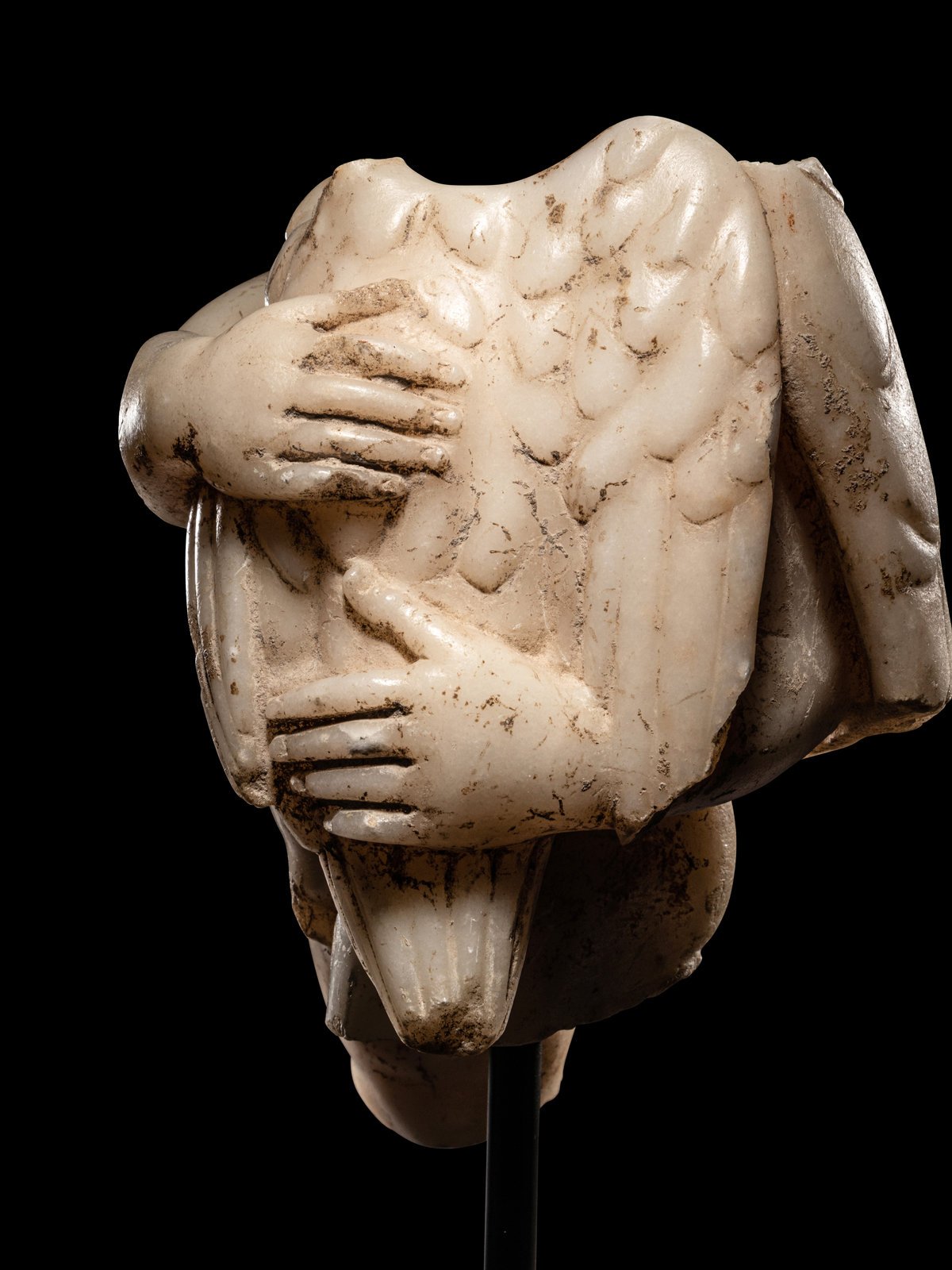Ancient Roman Bronze Handle
Ancient Roman Bronze Handle
Roman, 1st - 2nd century A.D.
Bronze
L: 17.4cm – D: 7.5
Serial: 42
The piece, the upstanding handle, is the only survived part of a vessel; however, its shape and design help to visualize the entire piece: a tall and ample ewer with wide mouth, probably a prochus used by the Romans for the cult libations or an oinochoe, a jug used at table service to pour wine into the drinking bowls. The handle was made separately and attached to the shoulders and the mouth of the vessel: its two curved terminals “embrace” the mouth and show precisely its form and size.
The bronze is a solid cast and presents a beautiful light-green patina. It is covered with elaborate figural reliefs composed in several registers. The lower portion, the escutcheon, which would be attached to the shoulders of the vessel, is shaped almost as medallion and includes the multi-figured composition called Bacchus in the vineyard. The god is seated on a low square base, probably a countryside altar; he is semi-nude, a long mantle covers his thighs where the folds are especially carefully arranged in a zigzag pattern, makes an overfold at his right shoulder and re-appears at his left shoulder and arm. He is also wearing a turbanlike headdress of loosely wound ribbons which is the attribute of the Indian Bacchus. This reminds of the god’s travels in the east, his presence in the east and west as a deity of fertility and wine.
His companion animal, a panther, depicted at his right as a playful pet, turns the head and looks upward at the figure of the baby Eros standing on the god’s right thigh and reaching the cluster of grapes above his head; another chubby Eros with similar small wings is seated on the ground on the left of the god and tries to reach his hand and attract his attention. From this side the group is enframed by the curving stem of the vine with two other clusters and leaves. The scene is designed in a landscape as it is suggested by the indication of the groundline on the lower part. The composition is well-balanced and symmetrical with corresponding pairs (standing Eros-vine stem, panther-seated Eros). The shapes are modeled with precision and have almost three-dimensional quality: one wonders if the bronze maker adapted an existing and known sculptural group for his relief representation
From this part the handle narrows, the next register of the band represents a standing Eros looking right and holding two objects (baskets?), his figure is arranged in a three-quarter view. His wings are not shown, but the body has the same proportions of the chubby children in the lower level. Above this figure there is a mask turned upside down, it represents a bearded hairy satyr, this type of the mask derives from the New Comedy. The upper register depicts the mythological story: the figure of the winged Eros walking left and pursuing a large butterfly, the image of Psyche. The lively scenes of Erotes with spatial effects, the proportions of their bodies with small wings are characteristic of the Hellenistic type in the iconography of Eros and remained popular among the images favored by the Roman artists and their sophisticated patrons.
At this point the handle is bending toward the top of the vessel; the surface received a rich and fine modeled ornament: two symmetrical vegetal scrolls and the flowers turned outward, and the two terminals turned inward which embrace the mouth: they are formed into the birds’ heads. Such a fantasy combination is typical for the ornamental designs in the Roman decorative arts, however here, instead of the usual swan’s or duck’s heads, the bronze maker chose the curved and elongated beak of the ibis. The overall surface of the piece is worn, and many details have vanished, - these heads preserved the initial treatment with incised eyes and teeth. There is a beautifully shaped foliate scroll, raised and arched, which marks the center of the attachment and dictates the symmetrical layout of the ornamental details in the mirror reflection.
This piece of the Roman Imperial period demonstrates the expertise of execution and the elaborate design implied to a piece of everyday life; vessels discovered in Pompeii possess a similar quality.
PROVENANCE: Ex-Gawain McKinley collection, London and New York, acquired before 1996.
BIBLIOGRAPHY: On turbaned Bacchus, see:
MATTUSCH C. C., Classical Bronzes: The Art and Craft of Greek and Roman Statuary, Ithaca and London, 1996, pp. 180-190.
COMSTOCK M. B., VERMEULE C. C., Greek, Etruscan and Roman Bronzes in the Museum of Fine Arts, Boston, Boston, 1971, pp. 332-333, no. 469.
Pompeii A.D. 79, Boston, 1978, p. 200, nos. 249-255.
Rediscovering Pompeii, Rome, 1990, pp. 197-201, nos. 105-107.









